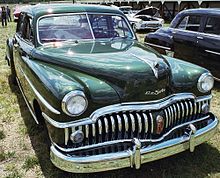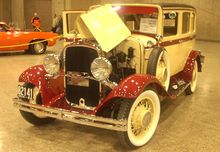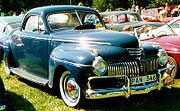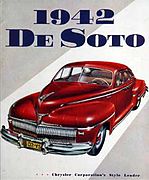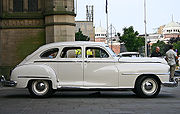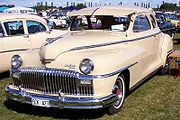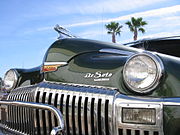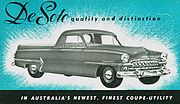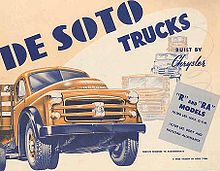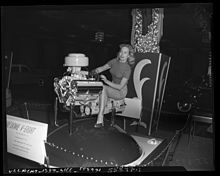- DeSoto (automobile)
-
The DeSoto (sometimes De Soto) was a brand of automobile based in the United States, manufactured and marketed by the Chrysler Corporation from 1928 to 1961. The DeSoto logo featured a stylized image of Hernando de Soto. The De Soto marque was officially dropped 30 November 1960, with a bit over two million built since 1928.[1]
Contents
1929–1942
The DeSoto make was founded by Walter Chrysler on August 4, 1928, and introduced for the 1929 model year. It was named after the Spanish explorer Hernando de Soto. Chrysler wanted to enter the brand in competition with its arch-rivals General Motors, Studebaker, and Willys-Knight, in the mid-price class.
Shortly after DeSoto was introduced, however, Chrysler completed its purchase of the Dodge Brothers, giving the company two mid-priced makes. Had the transaction been completed sooner, DeSoto never would have been introduced.
Initially, the two-make strategy was relatively successful, with DeSoto priced below Dodge models. Despite the economic times, DeSoto sales were relatively healthy, pacing Dodge at around 25,000 units in 1932. However, in 1933, Chrysler reversed the market positions of the two marques in hopes of boosting Dodge sales. By elevating DeSoto, it received Chrysler's streamlined 1934 Airflow bodies. But, on the shorter DeSoto wheelbase, the design was a disaster and was unpopular with consumers. Unlike Chrysler, which still had more traditional models to fall back on, DeSoto was hobbled by the Airflow design until the 1935 Airstream arrived.
Aside from its Airflow models, DeSoto's 1942 model is probably its second most memorable model from the pre-war years, when the cars were fitted with powered pop-up headlights, a first for a North American mass-production vehicle. DeSoto marketed the feature as "Air-Foil" lights "Out of Sight Except at Night".
Gallery
1946–1960
After wartime restrictions on automotive production were ended, DeSoto returned to civilian car production when it reissued its 1942 models as 1946 models, but without the hidden-headlight feature, and with fender lines extending into the doors, like other Chrysler products of the immediate postwar period.
Until 1952, DeSoto used the Deluxe and Custom model designations. In 1952 DeSoto added the Firedome with its 276-cid hemi engine. However, in 1953, DeSoto dropped the Deluxe and Custom names and designated its six-cylinder cars the 'Powermaster' and its V8 car remained the 'Firedome'.
At its height, DeSoto's more popular models included the Firesweep, Firedome, and Fireflite. The DeSoto Adventurer, introduced for 1956 as a high-performance hard-top coupe (similar to Chrysler's 300), became a full-range model in 1960.
In 1955,[2] along with all Chrysler models, De Sotos were redesigned with Virgil Exner's "Forward Look". DeSotos sold well through the 1956 model year. That year, for the first, and only, time in the marque's history, it served as Pace Car at the Indianapolis 500.[3] For the 1956 update Exner gave the DeSoto soaring tailfins fitted with triple taillights, and consumers responded by buying record numbers.
The 1957 had a well integrated design, with two variations: the smaller Firesweep, the Firedome/Fireflite body placed on the concurrent Dodge 122" wheelbase chassis with Dodge front fenders; and the Firedome and Fireflite (and its halo model Adventurer sub-series), based on the larger 126" wheelbase chassis shared with Chrysler. As was conventional in the era, subsequent years within the typical three year model block were distinguished by trim, bumper, and other low cost modifications, typically by adding bulk to bumpers and grilles, taillight changes, color choices, instrumentation and interior design changes and often additional external trim.
The 1958 economic downturn hurt sales of mid-priced makes across the board, and DeSoto sales were 60 percent lower than those of 1957 in what would be DeSoto's worst year since 1938. The sales slide continued for 1959 and 1960 (down 40 percent from the already low 1959 figures), and rumors began to circulate DeSoto was going to be discontinued.
Gallery
-
Late '40s model with Fluid Drive
-
1956 Firedome 2-door hardtop
1961
By the time the 1961 DeSoto was introduced in the fall of 1960, rumors were widespread that Chrysler was moving towards terminating the brand, fueled by a reduction in model offerings for the 1960 model year. The introduction of the value priced Chrysler Newport, a brand with more upscale market appeal, no doubt hastened the decision to end production of DeSoto, which was very similar in size, styling, price, and standard features.
For 1961, DeSoto lost its series designations entirely, in a move reminiscent of Packard's final lineup. And, like the final Packards, the final DeSoto was of questionable design merit. Again, based on the shorter Chrysler Windsor wheelbase, the DeSoto featured a two-tiered grille (each tier with a different texture) and revised taillights. Only a two-door hardtop and a four-door hardtop were offered. The cars were trimmed similarly to the 1960 Fireflite.
The final decision to discontinue DeSoto was announced on November 30, 1960, just forty-seven days after the 1961 models were introduced. At the time, Chrysler warehouses contained several million dollars in 1961 DeSoto parts, so the company ramped up production in order to use up the stock. Chrysler and Plymouth dealers, which had been forced to take possession of DeSotos under the terms of their franchise agreements, received no compensation from Chrysler for their unsold DeSotos at the time of the formal announcement. Making matters worse, Chrysler kept shipping the cars through December, many of which were sold at a loss by dealers eager to be rid of them. After the parts stock was exhausted, a few outstanding customer orders were filled with Chrysler Windsors.
Termination factors
Despite being a successful mid-priced line for Chrysler for most of its life, DeSoto's failure was due to a combination of corporate mistakes and external factors beyond Chrysler's control.
Recession
The 1958 recession, which seriously affected demand for mid-priced automobile makes, hurt DeSoto sales particularly badly, and sales failed to recover in 1959 and 1960. With falling sales, the 1959 and 1960 models were very similar to the concurrent Chryslers, and rumors began to circulate that DeSoto would be discontinued.
Dealer networks
Chrysler's dealer network also had an effect on the termination of DeSoto. Following World War II, Chrysler had a large number of dealers that carried two or more Chrysler makes, with DeSoto-Plymouth and Chrysler–Plymouth relationships being the most common. However, as Chrysler attempted to spin Plymouth off into stand-alone dealerships, existing dealers typically chose to become higher-volume Plymouth dealerships over the slower-selling DeSoto brand, leaving the marque with a weakened dealer network and fewer outlets selling its cars. Also, DeSoto Division's failure to adjust to changing market trends by introducing a new compact car model in 1960 as its GM and Ford counterparts, as well as its own Dodge and Plymouth siblings did, also hastened its demise.
Brand management and marketing
It was Chrysler's own brand management in 1950s, which pitted each of the five marques (Plymouth, Dodge, DeSoto, Chrysler and Imperial) against one other, that did the greatest damage to DeSoto and, ultimately, to the company itself in long-range product planning.[citation needed] Rather than carefully managing the market relationship to specific price points for all consumers, as General Motors had done so successfully, Chrysler allowed its own divisions to develop products targeting markets covered by their own sister divisions. Dodge was, by far, the most successful when it introduced the lower-priced Dodge Dart in 1960, advertising for which compared the Dart to the "C" car, the "F" car, and the "P" car—Chevrolet, Ford, and Plymouth. While Dart sales soared in 1960, they did so at the expense of Plymouth, which lost sales to the Dart. Plymouth, traditionally one of the "low priced three" fell out of third place, only to regain it twice (1971 and 1974) before its own demise in 2001.
Dodge moved upmarket with the Custom Royal in the mid-1950s which cut into and eroded Desoto's market. The introduction of the 1957 DeSoto Firesweep, a model that used the Dodge engine, chassis front fenders and hood, pushed DeSoto down into Dodge territory competing directly against the Custom Royal. The Firesweep sold well, but at the expense of the higher priced Firedome and Fireflite models. And the DeSoto began looking like a Chrysler with a different grille and taillights. In an era of strong make identification, DeSoto styling was a recipe for disaster.
When Chrysler marketing showed that consumers were likelier to buy an entry-level Chrysler than a DeSoto, Chrysler introduced the Chrysler Newport as a 1961 model, selling more than 45,000 units in its first year. At less than $3,000, the Newport covered the same price range as the 1961 DeSoto, which had sold 3,034 units total. Thus the DeSoto was dropped and replaced by Chrysler Newport.
Going in the opposite direction, Chrysler pushed into the luxury market by marketing the luxury 'Imperial' as a separate make and division starting in 1955. To make room for the new make,Chrysler Division began expanding downward, while Dodge Division began expanding upward, with larger and more luxurious models. Both Chrysler and Dodge began eating into DeSoto's already small market; and Chrysler's upper management did nothing to stop them.
DeSoto trucks
Chrysler Corporation introduced the DeSoto brand of trucks in 1937 to provide a greater number of sales outlets overseas for the American-built Dodge and Fargo commercial vehicles. The DeSoto brand was badge engineered sporadically on Dodge trucks made in Australia, Argentina, Spain, Turkey, and the UK.
Chrysler ended its truck operations in international markets. However, both the DeSoto and Fargo brands continue to be used on trucks made by Askam in Turkey. In 1978, Chrysler sold its share in the Askam venture to its Turkish partners.[4]
Models
- DeSoto Adventurer (1956–1960)
- DeSoto Airflow (1934–1936)
- DeSoto Airstream (1935–1936)
- DeSoto Custom (1946–1952)
- DeSoto Diplomat (Export)
- DeSoto Deluxe (1946–1952)
- DeSoto Firedome (1952–1959)
- DeSoto Fireflite (1955–1960)
- DeSoto Firesweep (1957–1959)
- DeSoto Powermaster (1953–1954)
- DeSoto Series K-SA (1929–1932)
- Desoto Series SC-SD (1933–1934)
- DeSoto Series S (1937–1942) (S-1 through S-10, except the Airstream and Airflow)
Advertising
DeSoto sponsored the popular television game show You Bet Your Life from 1950 through 1958, in which host Groucho Marx promoted the product by urging viewers to visit a DeSoto dealer with the phrase "tell 'em Groucho sent you". There was also a DeSoto Plymouth logo visible in the background all during the show.
The Cole Porter song "It's De-Lovely", with his permission, was used in DeSoto advertising between 1955 and 1957. "It's delovely, it's dynamic, it's DeSoto."
In popular culture
Films
- 1936 DeSoto Airstream 4 door sedan Taxicab in 1946 film The Big Sleep.
- 1940 DeSoto 4 door sedan in the 1993 Troma film Space Zombie Bingo. The car is used in a chase scene near the end of the film.
- 1949 DeSoto Custom in the 1960 film Classe Tous Risques (The Big Risk).[5]
- 1948 DeSoto Custom Club Coupe in the 1950 film "Sunset Blvd".
- 1951 DeSoto Custom Convertible in the 1957 film Le Feu aux Poudres (Burning Fuse).[6]
- 1954 DeSoto Firedome driven by Albert Einstein (Walter Matthau) in the 1994 film titled IQ.[7] Four door in the beginning of the film and convertible by the end.
- 1956 DeSoto Fireflite Convertible in the 1957 Federico Fellini film Le Notti di Cabiria (Nights of Cabiria).[8]
- 1956 DeSoto Firedome driven by Scottie Ferguson (James Stewart) in the 1958 Alfred Hitchcock classic Vertigo.[9]
- 1956 DeSoto Fireflite Convertible in the 1958 film La Vie à Deux (Life Together).[10]
- 1959 DeSoto Firesweep in the 1981 Australian post-apocalyptic action film Mad Max 2.
- 1959 DeSoto Firesweep Convertible in the 1991 film Mystery Date.[11]
- 1959 DeSoto Fireflite Convertible in the 1959 film Pillow Talk (Rock Hudson's car)
- 1961 DeSoto 4-door hardtop early in the 1988 film Mississippi Burning, from which a body is thrown into the street.[12]
Comic strips
- In the comic strip The Piranha Club, the character of Ernie Floyd drives a purple 1957 DeSoto Fireflite.
- In the comic strip Shoe, the main character, "Perfesser" Cosmo Fishhawk, drove a pink 1959 DeSoto.
- A 1960 DeSoto squad car serves as the main transportation for the comic book characters Sam & Max, and was also featured in the computer games Sam & Max Hit the Road, Sam & Max: Season One, Sam & Max: Season Two, and Sam & Max: Season Three.
Television
- For the majority of the 1950s themed TV show Happy Days, Mr. Cunningham drove a navy blue 1946 DeSoto.[13]
- In the 1956–58 Desilu syndicated series Sheriff of Cochise / U.S. Marshal series star John Bromfield drove a DeSoto station wagon with bulletproof glass.
- In the TV series Buffy the Vampire Slayer, the character Spike drove a 1959 DeSoto during Seasons 2 and 3. The car is often associated with the character in fan fiction.
- On the episode "Wheels" of the TV show Good Times, J.J. and three of his friends buy a pink 1954 DeSoto off of building superintendent Bookman for $200.
- In at least one episode of "Peter Gunn", the detective is seen driving a DeSoto.
- Was also widely talked about in the TV series M*A*S*H* by Hawkeye Pierce AKA:B.F.P. (Alan Alda) where he often talks about only buying American and owning a DeSoto.
See also
- List of automobile manufacturers
- List of defunct automobile manufacturers
References
- ^ Flory, J. Kelly (2004). American Cars, 1960-1972: Every Model, Year by Year. McFarland. p. 97. ISBN 9780786412730.
- ^ Flory, pp. 621 & 700.
- ^ Flory, p. 701.
- ^ "Company Profile". Askam. http://www.askam.com.tr/v2/english/company_profile.aspx. Retrieved 27 June 2011.
- ^ "Classe Tous Risques". IMCDb. http://www.imcdb.org/vehicle_9586-De-Soto-Custom-SP-13-1949.html. Retrieved 2010-09-27.
- ^ "Le Feu aux Poudres". IMCDb. http://www.imcdb.org/vehicle_60668-De-Soto-Custom-Convertible-S-15-2-1951.html. Retrieved 2010-09-27.
- ^ "I.Q.". IMCDb. http://www.imcdb.org/vehicle_140204-De-Soto-Firedome-S-19-1954.html. Retrieved 2010-09-27.
- ^ "Le Notti di Cabiria". IMCDb. http://www.imcdb.org/vehicle_59177-De-Soto-Fireflite-Convertible-S-24-1956.html. Retrieved 2010-09-27.
- ^ "Vertigo". IMCDb. http://www.imcdb.org/vehicle_6266-De-Soto-Firedome-Sportsman-S23-1956.html. Retrieved 2010-09-27.
- ^ "La Vie à Deux". IMCDb. http://www.imcdb.org/vehicle_71884-De-Soto-Fireflite-Convertible-1956.html. Retrieved 2010-09-27.
- ^ "Mystery Date". IMCDb. http://www.imcdb.org/vehicle_51412-De-Soto-Firesweep-1959.html. Retrieved 2010-09-27.
- ^ "Mississippi Burning". IMCDb. http://www.imcdb.org/vehicle_139674-De-Soto-RS1-L612-1961.html. Retrieved 2010-09-27.
- ^ "Happy Days". IMCDb. http://www.imcdb.org/vehicle_147533-De-Soto-De-Luxe-S-11-S-1946.html. Retrieved 2010-09-27.
- Foster, Kit (October 2004). "1960–61 DeSoto: The End of Adventure". Collectible Automobile Magazine 21 (3): 34–47.
- Kimes, Beverly R.; Clark, Henry A. (1996). The Standard Catalog of American Cars 1805-1945. Krause Publications. ISBN 9780873414289.
- Gunnell, John, ed (1987). The Standard Catalog of American Cars 1946-1975. Krause Publications. ISBN 9780873410960.
External links
- The Ultimate 1957 DeSoto Pages
- National DeSoto Club
- DeSotoland
- Walter P. Chrysler Club
- Old De Soto Ads
- IMCDb.org: DeSoto in movies and TV series
- DeSoto trucks. Automotive oddity
- Askam Kamyon Imalat - DeSoto trucks made in Turkey
A product of the Chrysler CorporationChrysler Marques CurrentDefunctAMC (1966–1988) · Commer (1905–1979) · Barreiros (1959–1978) · DeSoto (1928–1961) · Eagle (1988–1998) · Fargo (1920–1972) · Hillman (1907–1976) · Humber (1898–1975) · Imperial (1955–1975, 1981–1983) · Karrier (1908–1977) · Plymouth (1928–2001) · Singer (1905–1970) · Simca (1934–1977) · Sunbeam (1901–1976) · Valiant (1960–1966)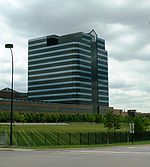
Divisions and
subsidiariesCurrentChrysler Australia · Chrysler Canada · Dodge · Jeep · Mopar · Ram Trucks · Street and Racing Technology (SRT) · Road Track (R/T)DefunctAmerican Motors Corporation (1954–1988) · Chrysler Australia (1951–1981) · Chrysler Europe (1967–1981) · Chrysler-Plymouth · Chrysler UK (1970–1981) · EnviFormerJoint ventures and
alliancesCurrentDefunctPeople Walter Chrysler · Lee Iacocca · C. Robert Kidder · Thomas W. LaSorda · Sergio Marchionne · Louis RhodesPlaces Products Other Big Three · Cerberus Capital Management · Daimler-Chrysler (1998–2007) · Fiat SpA · History (Chapter 11 reorganization)
Categories:- Chrysler
- Defunct motor vehicle manufacturers of the United States
- DeSoto vehicles
- 1920s automobiles
- 1930s automobiles
- 1940s automobiles
- 1950s automobiles
- 1960s automobiles
Wikimedia Foundation. 2010.


